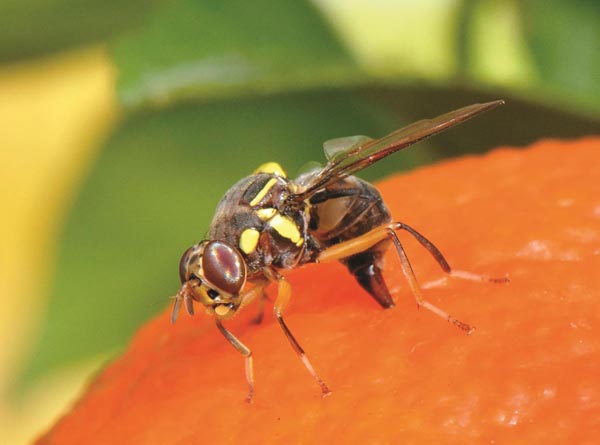What's in a name? Everything — if you're a fruit fly

This is an Oriental fruit fly. Credit: Ana Rodriguez
For twenty years some of the world's most damaging pest fruit flies have been almost impossible to distinguish from each other. The ability to identify pests is central to quarantine, trade, pest management and basic research.
In 2009 a coordinated research effort got underway to definitively answer this question by resolving the differences, if any, between five of the most destructive fruit flies: the Oriental fruit fly, the Philippine fruit fly, the Invasive fruit fly, the Carambola fruit fly, and the Asian Papaya fruit fly. These species cause incalculable damage to horticultural industries and food security across Asia, Africa, the Pacific and parts of South America.
The Philippine fruit fly was formally recognised as the same species as the Asian Papaya fruit fly in 2013. The latest study goes further, conclusively demonstrating that they are also the same biological species as the Oriental and Invasive fruit flies. These four species have now been combined under the single name: Bactrocera dorsalis, the Oriental fruit fly. The closely-related Carambola fruit fly remains distinct.
Professor Tony Clarke, Chair of Fruit Fly Biology and Management from the Plant Biosecurity Cooperative Research Centre (PBCRC) and the Queensland University of Technology (QUT), believes the integrated multidisciplinary nature of the project leaves little doubt the species are identical.
“More than 40 researchers from 20 countries examined evidence across a range of disciplines, using morphological, molecular, cytogenetic, behavioural and chemoecological data to present a compelling case for this taxonomic change,” he said.
“This outcome has major implications for global plant biosecurity, especially for developing countries in Africa and Asia,” said Professor Clarke.
“For example, Invasive (now Oriental) fruit fly has devastated African fruit production with crop losses exceeding 80 per cent, widespread trade restrictions with refusal of shipments into Europe and Japan, and significant economic and social impacts to farming communities.”
Keeping exotic fruit fly out is a major concern for Australian biosecurity agencies. While an outbreak of Papaya fruit fly near Cairns in the mid-1990s inflicted $A100 million in eradication and industry costs, current estimates rate the Oriental fruit fly as the biggest threat to Australian plant biosecurity, with the total cost to the nation of an invasion estimated at $A1 billion. Combining the four species will mean a major reassessment of Australia's exotic fruit fly risk.
“Globally, accepting these four pests as a single species will lead to improved international cooperation in pest management, more effective quarantine measures, reduced barriers to international trade, the wider application of established post-harvest treatments, improved fundamental research and, most importantly, enhanced food security for some of the world's poorest nations,” said Professor Clarke.
###
The paper, 'B. papayae, B. invadens, and B. dorsalis synonymy', has been published in the journal Systematic Entomology: http://onlinelibrary.wiley.com/doi/10.1111/syen.12113/abstract and is a collaboration between 33 research organisations in 20 countries, supported by the Food and Agriculture Organisation of the United Nations and the International Atomic Energy Agency.
More information and interviews: Tony Steeper, PBCRC Communications Manager, 0417 697 470, t.steeper@pbcrc.com.au
Media Contact
More Information:
http://pbcrc.com.auAll latest news from the category: Life Sciences and Chemistry
Articles and reports from the Life Sciences and chemistry area deal with applied and basic research into modern biology, chemistry and human medicine.
Valuable information can be found on a range of life sciences fields including bacteriology, biochemistry, bionics, bioinformatics, biophysics, biotechnology, genetics, geobotany, human biology, marine biology, microbiology, molecular biology, cellular biology, zoology, bioinorganic chemistry, microchemistry and environmental chemistry.
Newest articles

NASA: Mystery of life’s handedness deepens
The mystery of why life uses molecules with specific orientations has deepened with a NASA-funded discovery that RNA — a key molecule thought to have potentially held the instructions for…

What are the effects of historic lithium mining on water quality?
Study reveals low levels of common contaminants but high levels of other elements in waters associated with an abandoned lithium mine. Lithium ore and mining waste from a historic lithium…

Quantum-inspired design boosts efficiency of heat-to-electricity conversion
Rice engineers take unconventional route to improving thermophotovoltaic systems. Researchers at Rice University have found a new way to improve a key element of thermophotovoltaic (TPV) systems, which convert heat…



